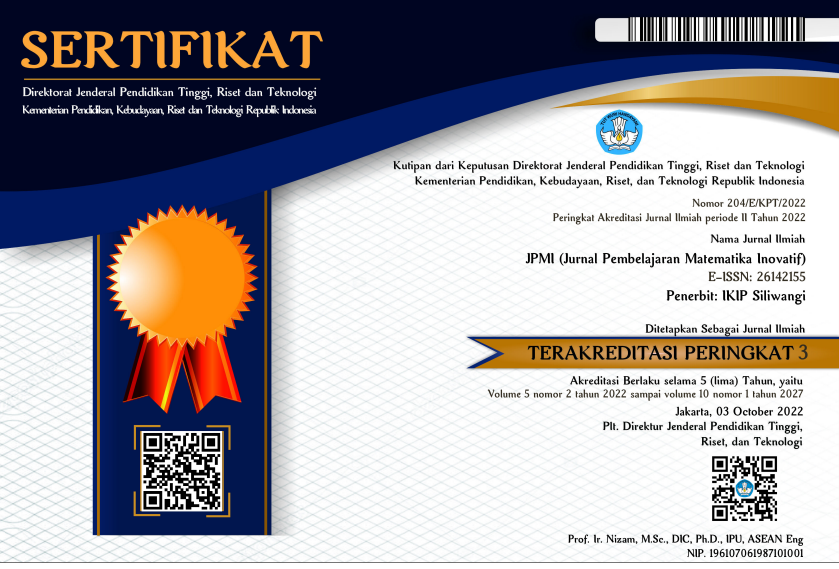PENERAPAN PENDEKATAN CTL UNTUK MENINGKATKAN KAPASITAS BERPIKIR KRITIS MATEMATIK PESERTADIDIK DI TINGKAT SMP
DOI:
https://doi.org/10.22460/jpmi.v1i6.p1063-1070Keywords:
Pendekatan CTL, Berfikir Kritits MatematikAbstract
The research objective is to examine the achievement of mathematical critical thinking capacity of students applying the CTL approach with a comparison of students applying ordinary learning and examining the extent to which the increasing capacity of critical thinking in mathematics students apply the CTL approach to the comparison of students who apply ordinary learning. The study population was all junior high schools in West Bandung regency, were chosen arbitrarily and were selected by Darul Hikmah Junior High School. The sample is taken by any selected class of class 7-A as a research class, and class 7-B as a review class. The research class is given a learning model with the CTL approach, and the review class is given an ordinary learning model. The research instruments used in mathematical critical thinking capacity tests take the form of descriptions. Data processing increases the capacity of critical thinking mathematically by applying tests that distinguish two means using IBM SPSS 23 software. Data from the analysis showed that the achievement and improvement of the critical thinking capacity of the mathematics of the participants who were given the learning method using the CTL approach was better than those of the participants who were given the usual learning method.
References
Afrilianto, M. (2012). Peningkatan Pemahaman Konsep dan Kompetensi Strategis Matematis Siswa SMP dengan Pendekatan Metaphorical Thinking. Infinity Journal, 1, 192–202.
Akmalia, D. Jumiati, M. S. (2011). Peningkatan Hasil Belajar Siswa dengan Menggunakan Model Numbereds Heads Together (NHT) pada Materi Gerak Tumbuhan di Kelas VIII SMP Sei Putih Kampar. Lextura, 2, 2.
Fachrurazi. (2011). Penerapan Pembelajaran Berbasis Masalah untuk Meningkatkan Kemampuan Berpikir Kritis dan Komunikasi Matematis Siswa Sekolah Dasar. Portal Jurnal UPI. Bandung: Edisi Khusus.
Hendriana, H. Soemarmo, U. (2014). Penilaian Pembelajaran Matematika. Cimahi: Refika Aditama.
Hendriana, H. (2015). Kemampuan Metaphorical Thinking Guru Dalam Mengembangkan Pembelajaran Matematika. Infinity Journal, 1, 10–16.
Maulida, L. (2014). Penerapan Pendekatan Contextual Teaching and Learning Untuk Meningkatkan Aktivitas Belajar Matematika di Kelas IV Min Parung. Jakarta: UIN Syarif Hidayatullah.
Munika, S. (2015). Pengaruh Model Pembelajaran Learning Cycle 5E Terhadap Kemampuan Berpikir Kritis Matematis Siswa. Jakarta: Tidak diterbitkan.
Purwatiningsi, S. (2013). Penerapan Metode Penemuan Terbimbing untuk Meningkatkan Hasil Belajar Siswa pada Materi Luas Permukaan dan Volume Balok. Jurnal Elektronik Pendidikan Matematika Tadulako, 1, 1.
Ramdhani, A. (2016). Pengaruh Pendekatan Model-Eliciting Activities Terhadap Kemampuan Berpikir Kritis Matematik Siswa SMP Negeri di Kota Cimahi. In Skripsi STKIP Siliwangi. Cimahi: Tidak diterbitkan.
Rohaeti, E. E. (2008). Pembelajaran dengan Pendidikan Eksplorasi untuk Mengembangkan Kemampuan Berpikir Kritis dan Kreatif Matematik Siswa SMP. Bandung: Tidak diterbitkan.
Ruseffendi, E. T. (2006). Pengantar kepada Membantu Guru Mengembangkan Kompetensinya dalam Pelajaran Matematika untuk Meningkatkan CBSA. Bandung: Tarsito.
Sakdiyah. (2012). Pengaruh Pendekatan Kontekstual Terhadap Hasil Belajar. Jurnal Serambi Ilmu, 7, 1.
Sumarmo, U. (2012). Bahan Belajar Mata Kuliah Proses Berpikir Matematik Program S2 Pendidikan Matematika STKIP Siliwangi 2012. Bandung: Tidak diterbitkan.
Suryani dan Agung. (2012). Strategi Belajar Mengajar. Yogyakarta: Ombak.
Suwangsih, E, dkk. (2006). Model Pembelajaran Matematika. Bandung: UPI PRESS.
Uyanto, S. (2009). Pedoman Analisis Data dengan SPSS. Bandung: Graha Ilmu.
Yamin. (2013). Paradigma Baru Pembelajaran. Jakarta: Referensi.

















